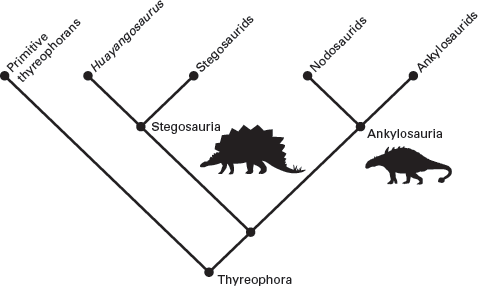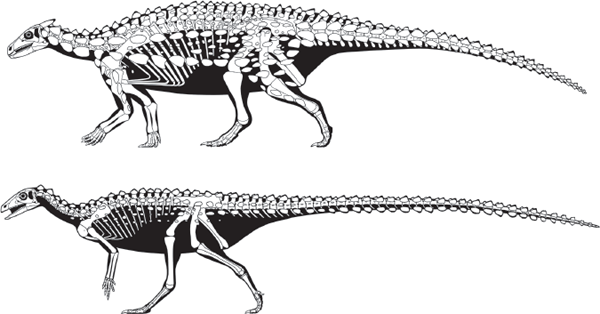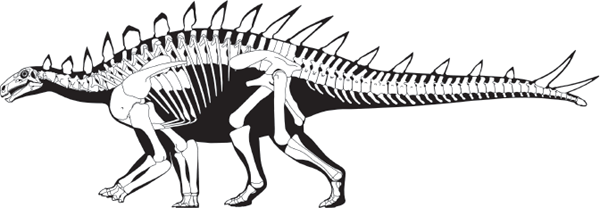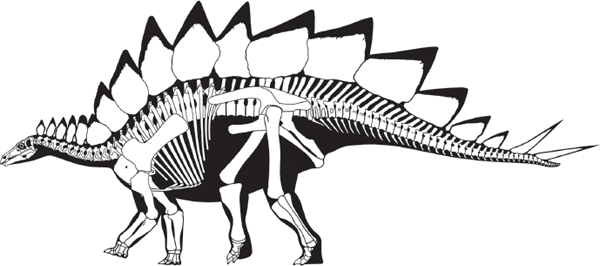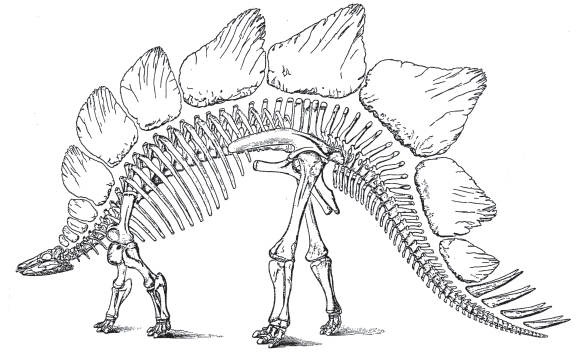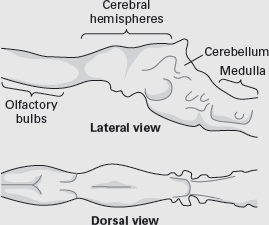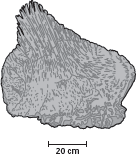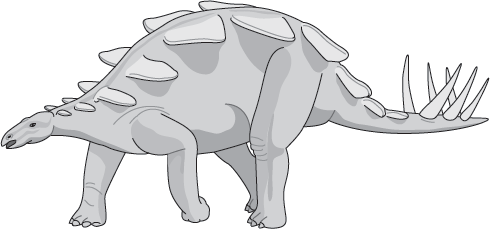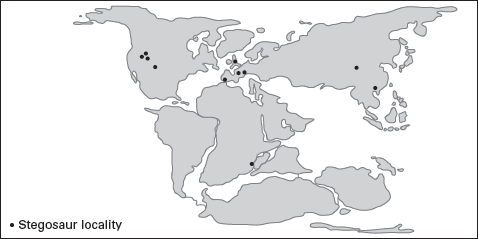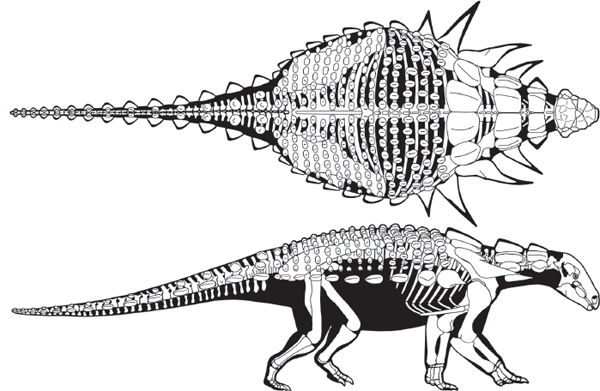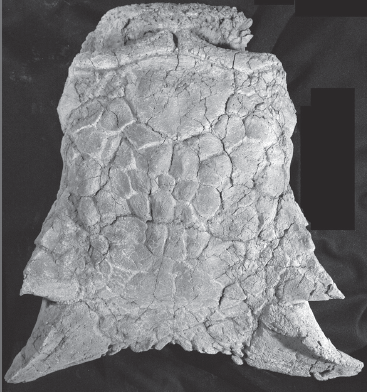STEGOSAURUS is one of the most familiar dinosaurs, and the armadillo-like
Ankylosaurus is also quite well known. Paleontologists consider the stegosaurs (plated dinosaurs) and ankylosaurs (armored dinosaurs) to be closely related and have united them in a group with the unwieldy name
Thyreophora (shield bearers) (
figure 8.1). Thyreophorans were a diverse group of armored, primarily quadrupedal ornithischians of Jurassic and Cretaceous age with a virtually worldwide distribution. The key evolutionary novelty of thyreophorans is the presence of one or more rows of
armor plates in the skin above or alongside the vertebral column. In this chapter, I review the anatomy and evolution of thyreophoran dinosaurs.
Not all thyreophorans can be assigned to the stegosaurs or ankylosaurs. The most primitive of the thyreophorans are also among the most primitive ornithischians. Two of these dinosaurs—Scutellosaurus and Scelidosaurus—provide us with a look at the early diversity of the Thyreophora.
Scutellosaurus was a relatively small (about 1.3 meters long) generalized ornithischian (
figure 8.2). It had a small skull and jaws, cheek teeth positioned on the jaw margins, a short neck, hind limbs only slightly longer than the forelimbs, and a long tail. These are primitive ornithischian characteristics and explain why some paleontologists consider
Scutellosaurus to be closely related to primitive ornithischian dinosaurs like
Lesothosaurus. However,
Scutellosaurus had an extensive body covering of bony plates set in the skin (
figure 8.3), which is an evolutionary novelty of thyreophorans that justifies the inclusion of
Scutellosaurus in this group. Evolutionary novelties of the skull and lower jaw, including the sinuous lower cheek tooth row, distinguish stegosaurs and ankylosaurs from the most primitive thyreophorans.
FIGURE 8.1
Thyreophoran dinosaurs include the stegosaurs, the ankylosaurs, and some primitive forms, as shown in this cladogram. (Drawing by Network Graphics)
Of course, it is possible that Scutellosaurus evolved its body armor independently of the evolution of body armor in thyreophorans. In this case, the similarity in body armor between Scutellosaurus and thyreophorans would reflect evolutionary convergence and not a close phylogenetic relationship. At present, though, the body armor of Scutellosaurus is best viewed as genuinely thyreophoran, especially because it shows detailed and unique similarity—dorsal keels and ventral excavations—to the body armor of certain other thyreophorans.
FIGURE 8.2
Early Jurassic Scelidosaurus (above) and Scutellosaurus (below) were primitive Jurassic thyreophorans that lacked the evolutionary novelties of either stegosaurs or ankylosaurs. (© Scott Hartman)
FIGURE 8.3
The armor plates of Scutellosaurus were characteristically thyreophoran: they were keeled dorsally and excavated ventrally. (Drawing by Network Graphics)
Scelidosaurus is another primitive thyreophoran (see
figure 8.2), but it was very different from
Scutellosaurus. Much larger (at least 4 meters long),
Scelidosaurus had a small skull with simple, leaf-shaped teeth that ran to the tip of the snout. Its limbs were massive, and the fore- and hind limbs were of nearly equal length. The skull of
Scelidosaurus lacked armor plating, but its back was covered by numerous bony plates embedded in the skin. These plates were remarkably similar to those of the ankylosaurs. The extremely broad sacrum of
Scelidosaurus is another feature that unites it with thyreophorans. Because no complete articulated skeleton of
Scelidosaurus has been discovered, the arrangement of the armor plates on its back remains somewhat uncertain. The most complete known skeleton, described by Richard Owen in 1863, suggests that the plates formed a broad covering across the back and sides of the dinosaur as in later ankylosaurs (see
figure 8.2)
As in Scutellosaurus, much of the anatomy of Scelidosaurus is primitively ornithischian. But this quadruped (possibly a facultative biped), with its extensive body armor and broad sacrum, can be more readily allied with the thyreophorans. Indeed, some paleontologists have gone so far as to assign Scelidosaurus to the stegosaurs or the ankylosaurs. But, because the specific evolutionary novelties that distinguish stegosaurs and ankylosaurs are not present in Scelidosaurus, it is best regarded as neither stegosaur nor ankylosaur, but as a primitive thyreophoran.
Scutellosaurus fossils are known from the Lower Jurassic of Arizona, whereas those of Scelidosaurus are known from the Lower Jurassic of Great Britain. Another primitive thyreophoran is Emausaurus, known from a skull and partial skeleton collected in the Lower Jurassic of Germany. Known primitive thyreophorans were so different from each other and so widely separated geographically that we can be sure much more remains to be discovered about the origin and early evolution of the shield-bearing dinosaurs.
The Stegosauria, meaning “plated lizards” because of the armor plates on these dinosaurs’ backs, were medium-size to large (up to 9 meters long), quadrupedal, herbivorous ornithischians. They had small heads; short and massive forelimbs; long, columnar hind limbs; and short, stout feet that bore hooves on the ends of the toes. The key evolutionary novelty of stegosaurs was the vertical bony plates and spines arranged in single or double rows along the neck, back, and tail. The most primitive well-known stegosaur is Huayangosaurus, from the Middle Jurassic of China. A poorly known but even more primitive stegosaur may be Gigantspinosaurus, from the Upper Jurassic of China. Other more advanced stegosaurs are placed in the family Stegosauridae.
Huayangosaurus, from the Middle Jurassic of Sichuan Province, China, is the most completely known primitive stegosaur (
figure 8.4). This 4.3-meter-long stegosaur had spike-shaped armor along the midline of its body and additional rows of small armor plates along each side of the row of spikes. Unlike more advanced stegosaurids,
Huayangosaurus had a rather deep (tall) skull with a short snout. The eye sockets were located relatively far forward, above the posterior cheek teeth.
Huayangosaurus was smaller and less massive than stegosaurids and had fore- and hind limbs that were not as equal in length. Other differences between
Huayangosaurus and stegosaurids may be found in details of the structure of the shoulder and hip girdles.
Huayangosaurus is known from several complete skeletons and is thus one of the best-known stegosaurs. However, to examine the origin of stegosaurs, we must still bridge the considerable anatomical gap between primitive Early Jurassic thyreophorans, such as Scelidosaurus, and primitive stegosaurs, such as Huayangosaurus.
FIGURE 8.4
Huayangosaurus, from the Middle Jurassic of China, was one of the most primitive stegosaurs. (© Scott Hartman)
All stegosaurs other than
Gigantspinosaurus and
Huayangosaurus are placed in the family
Stegosauridae. Stegosaurids are easily distinguished from
Huayangosaurus by their relatively low skulls (that is, not “tall” when measured top to bottom) with long snouts and posteriorly located eye sockets (behind the cheek-tooth row), larger size, more massive skeletons, and relatively long hind limbs. Best known and typical of the stegosaurids is
Stegosaurus, from the Upper Jurassic of the western United States (
figure 8.5). Other well-known stegosaurids are
Kentrosaurus, from the Upper Jurassic of Tanzania, and
Tuojiangosaurus, from the Upper Jurassic of China (
figure 8.6). The remaining stegosaurids are known from much less complete fossils.
Like all stegosaurids,
Stegosaurus had only a midline row of armor plates. The exact arrangement of these plates has been debated (
box 8.1), but the alternating, offset row of plates seen in most skeletal reconstructions is favored here (see
figure 8.5).
Stegosaurus had a low, slender and, for an animal that weighed 1 to 2 tons, very small head. The tip of the snout formed a narrow, toothless beak. The cheek teeth were leaf-shaped with small denticles on the edges, as in many groups of plant-eating dinosaurs. These teeth did not, however, form the dental batteries seen in the ornithopods (see
chapter 7). The brain in the skull of
Stegosaurus was truly tiny and is estimated to have weighed about 70 to 80 grams (2.5 to 2.9 ounces). Indeed, the small skull and tiny brain of
Stegosaurus have led to the popular notion that it was one of the “stupidest” dinosaurs (
box 8.2).
FIGURE 8.5
Late Jurassic Stegosaurus was characteristic of the more advanced stegosaurs, the stegosaurids. (© Scott Hartman)
FIGURE 8.6
Kentrosaurus, from the Upper Jurassic of Tanzania (above), and Tuojiangosaurus, from the Upper Jurassic of China (below), are other well-known stegosaurids. (© Scott Hartman)
As in other thyreophorans, the armor plates of
Stegosaurus were anchored in the skin and not attached to other bones, so they usually fell out of place before fossilization occurred. One of the oldest clues to their arrangement remains the best clue, even today, and is seen in the remarkably well-preserved fossil skeleton of a
Stegosaurus from Colorado described in 1901 (
box figure 8.1A). This skeleton was found lying on its side and shows some overlap in the anterior and posterior ends of successive plates. But, rather than clearly demonstrating the arrangement of plates on the back of
Stegosaurus, it has fostered two opposing views.
Prior to the discovery of the Colorado specimen, Yale University paleontologist Othniel Charles Marsh reconstructed the skeleton of
Stegosaurus with its plates arranged in a single row (
box figure 8.1B). The overlapping plates of the Colorado specimen, however, suggested to Smithsonian paleontologist Frederick Lucas that the plates were arranged in an alternating pattern in two rows (see
figure 8.5). But, those who defended Marsh’s original reconstruction suggested that the overlap of the plates of the Colorado specimen was a result of distortion of the skeleton after the dinosaur died.
In 1987, paleontologist and artist Stephen Czerkas reviewed ideas about the arrangement of
Stegosaurus plates and argued they were arranged in a single row, as Marsh originally believed. Czerkas pointed out that on the Colorado skeleton, only the anterior and posterior tips of the plates overlap. If there had been two rows of plates, he reasoned, we would see more overlap. Czerkas also noted, as had some earlier paleontologists, that the neck, back, and tail of
Stegosaurus were long enough to allow the plates to be arranged in a single row with just a slight overlap of plates in the neck, shoulder, and back regions. Yet, despite the force of Czerkas’s arguments, most paleontologists still find impressive the argument that the plates of
Stegosaurus functioned best as radiators when arranged in two alternating rows, as shown in
figure 8.5. Indeed, recently discovered skeletons of
Stegosaurus from Colorado and Utah confirm the overlap of the plates.
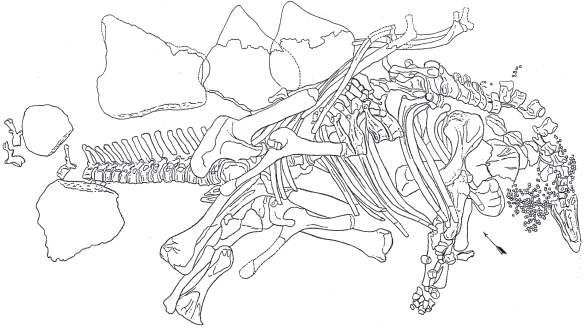
BOX FIGURE 8.1A
This skeleton of Stegosaurus from Colorado, shown here as it was found in the rock, is the best direct evidence of the arrangement of the plates of Stegosaurus. (From C. W. Gilmore, and the United States National Museum. 1914. Osteology of the Armored Dinosauria in the United States National Museum with Special Reference to the Genus Stegosaurus. Washington, D.C.: Government Printing Office)
BOX FIGURE 8.1B
The first reconstruction of Stegosaurus by Othniel Charles Marsh, in 1891, showed a single row of plates that do not overlap. (From E. H. Colbert. 1984. The Great Dinosaur Hunters and Their Discoveries. Mineola, N.Y.: Dover. Reprinted by permission of Dover Publications, Inc.)
The small size of the brain of Stegosaurus is legendary. Variously described as “the size of a walnut” or “smaller than a kitten’s brain,” the brain of Stegosaurus has led to the popular notion that it was one of the “dumbest” dinosaurs.
Our knowledge of the brain of Stegosaurus, or for that matter the brain of any dinosaur, rests on endocasts (short for “endocranial casts”). An endocast is a cast (replica) of the inside of a dinosaur’s braincase. It is prepared by carefully cleaning the rock out of the interior of a dinosaur skull and then filling the cleaned braincase with soft rubber (usually latex) that can be pulled out of the opening for the spinal cord after the rubber cures. The flexible rubber must be compressed to pull it out through the spinal cord opening, but then it regains its shape. The resulting endocast is an accurate replica of the overall shape and size of the brain cavity, and it also records the positions of the major nerves and blood vessels that entered and exited the brain.
The endocast of the brain of
Stegosaurus reveals a typically reptilian brain that had much more in common with the brain of a lizard than with the brain of a mammal (
box figure 8.2). The brain of
Stegosaurus was long and low, and it lacked much of a curve in the region of the cerebrum. The front of the brain, which included the olfactory bulbs associated with the sense of smell, was extraordinarily large, but the cerebrum and cerebellum were small, while the medulla was long and large.
BOX FIGURE 8.2
The endocast of Stegosaurus resembles that of a living lizard. (Drawing by Network Graphics)
The endocast of
Stegosaurus only displaces about 56 milliliters of water. Computer analysis of a different
Stegosaurus skull estimated an endocast volume of about 64 milliliters. A living lizard enlarged to the size of
Stegosaurus, however, would have an endocast volume of about 110 milliliters. The endocast of a living, fully grown house cat displaces about 30 milliliters of water. The average walnut from a grocery store displaces only 15 to 20 milliliters of water. And, when we look at the endocasts of a variety of dinosaurs,
Stegosaurus does have one of the smallest brain volumes relative to its body size (see
chapter 14).
Stegosaurus thus does not stand out as particularly “brainy” by any standard. Nevertheless, its brain was bigger than a walnut or a kitten’s brain, so the intelligence of Stegosaurus has been somewhat maligned. Furthermore, stegosaurs were very successful land animals for at least 100 million years, more than 30 times the duration of the human species. Perhaps the best conclusion we can reach about stegosaur intelligence is that these dinosaurs were as intelligent as they had to be!
Some who have wondered how a 1- to 2-ton Stegosaurus functioned with a 2- to 3-ounce brain have pointed to the enlarged spinal cavity in its hip region as the possible location of a “second brain.” However, no living reptile has a “second brain” located in the hip region. This enlargement, which is a cavity at least 20 times the size of a stegosaur brain, may have been an area where extra nerves met from the tail and hind limbs. But, a more likely explanation is that this cavity of Stegosaurus was for the storage of fat and sugar, as is seen today in some birds, such as ostriches.
The long neck and tail of
Stegosaurus are typical features of stegosaurids. The powerfully built forelimbs of this dinosaur featured a shoulder blade and humerus with thick bony crests for the attachment of massive shoulder and upper arm muscles. This structure suggests a semi-sprawling posture for the forelimb when walking. The forefoot had five short, broad toes with hoof-like tips. In contrast, the hind limbs of
Stegosaurus were extremely long and pillar-like. The long, columnar femur lacking broad flanges of bone suggests an upright hind limb posture when walking. Unlike the forefeet, the hind feet of
Stegosaurus bore three short, stout toes with hooves.
The armor of
Stegosaurus included numerous, small, knob-like plates that were distributed in the skin over most of the body. Most prominent, though, were the plates along the backbone. The plates immediately behind the head were small, flat and had irregularly shaped edges. Large, diamond-shaped plates followed and extended down the back onto the tail. The plates were largest over the hips. The plates were not solid sheets of bone; instead, their surfaces were covered with grooves and channels, and their interiors contained large canals (
figure 8.7). Clearly, blood could flow into and around the plates of
Stegosaurus. The row of plates was followed by two pairs of long spikes located at the end of the tail.
For nearly a century, paleontologists believed that
Stegosaurus used its plates as defensive armor. Various illustrations from earlier times showed
Stegosaurus protecting itself from attacking predators with its plates. Some drawings even showed the plates lying nearly flat against the sides of the dinosaur’s body, although even, in this situation, relatively little of the back and flanks of the dinosaur would have been shielded (
figure 8.8).
FIGURE 8.7
The plates of Stegosaurus were not solid sheets of bone, but were instead covered with grooves and canals for blood vessels. (Drawing by Network Graphics)
FIGURE 8.8
This restoration of Stegosaurus with its plates lying flat shows just how little of the body and flanks of the dinosaur would have been covered by the plates. (Drawing by Network Graphics)
There are two reasons to question the idea that the plates of
Stegosaurus were defensive armor. The first, as already stated, is that these plates, however they were arranged, only covered a small portion of the back and flanks of the dinosaur, leaving the belly and legs entirely unprotected. The second is the vascularization of the plates, which suggests that they were regularly and extensively filled with blood. It simply doesn’t make sense to expose a blood-filled structure to an attacker.
A much more reasonable interpretation of the function of the plates of Stegosaurus stems from an elegant analysis undertaken by James Farlow and colleagues at Yale University during the late 1970s. These scientists argued, by analogy with living reptiles, that the plates of Stegosaurus functioned as radiators and solar panels that helped to regulate the dinosaur’s body temperature. Pumping blood through the plates would have increased the surface area over which the blood was exposed so it could rapidly be cooled (in the shade) or heated (in the sun). A similar process cools the water in an automobile engine when the water is pumped into the radiator where numerous flat chambers increase its surface area. Living lizards also achieve rapid heating of their blood by flattening their bodies on warm rocks in the sun to increase the surface area over which their blood is exposed.
Farlow and colleagues tested the idea of
Stegosaurus plates functioning as radiators and solar panels by modeling a
Stegosaurus as a metal cylinder with slots on top into which they could place small metal plates. When this cylinder was heated, it was found to cool most quickly when the plates were diamond-shaped and arranged in two alternating rows. This strongly suggests that the plates of
Stegosaurus functioned most effectively as radiators and solar panels when arranged in two alternating rows as shown in most reconstructions of
Stegosaurus (see
figure 8.5).
This analysis of the function of the plates of Stegosaurus seems convincing, but does it apply to the other stegosaurs? Huayangosaurus had spikes, not plates, and the arrangement and shape of the plates of other stegosaurids, such as Kentrosaurus and Tuojiangosaurus, are not as functionally optimal as Stegosaurus. Furthermore, the paired tail spikes of Stegosaurus do not fit into the model of thermoregulation and probably did function as defensive structures. Perhaps the best explanation is that stegosaur midline armor originally evolved as defensive spikes like those of Huayangosaurus. In some later stegosaurs, such as Stegosaurus, the shape and arrangement of the midline armor became modified for optimum efficiency as radiators and solar panels. The earlier stegosaurids may have had less efficient radiators and solar panels and may still have employed the plates, to some extent, in defense. Whatever else stegosaurs did with their midline armor, it likely also functioned in display as a device for recognizing members of the same species.
Stegosaur skulls and teeth indicate they were plant-eaters that cropped vegetation with their horny beaks, then sliced it with their teeth before swallowing. Their limb structures suggest they were habitual quadrupeds that weighed as much as 2 tons. Stegosaurs probably could have reared up on their pillar-like hind limbs, but they browsed primarily on vegetation at a height of 1 meter or less above the ground.
Middle Jurassic stegosaur footprints are known primarily from the United States. The oldest stegosaur skeletons are from the Middle Jurassic of China and Europe. By the Late Jurassic, stegosaurs had achieved a nearly worldwide distribution and reached the zenith of their diversity, at least eight genera (
figure 8.9). Stegosaurs were among the dominant large plant-eaters of the Late Jurassic, and their fossils are common in Upper Jurassic nonmarine rocks, especially in southern China, the western United States, and eastern Africa.
FIGURE 8.9
This map of stegosaur distribution shows that the stegosaurs lived nearly worldwide during the Late Jurassic. (Drawing by Network Graphics)
The Cretaceous record of stegosaurs is much sparser, and by the Cretaceous, the stegosaurs were clearly past their peak. The Cretaceous decline of stegosaurs is usually linked to the appearance of new types of plants (the flowering plants), new types of plant-eating dinosaurs (especially the large ornithopods), or both. Stegosaurs apparently were extinct by the beginning of the Late Cretaceous.
The ankylosaurs (meaning “fused lizards” because of the rod of fused vertebrae in their backs) were medium-size to large (up to 9 meters long), quadrupedal, plant-eating ornithischians. They had small heads with leaf-shaped, non-interlocking teeth, similar to the teeth of stegosaurs. The broadly arched ribs of ankylosaurs formed a very wide body, which was covered with small round or square armor plates that produced a fairly continuous shield over its dorsal surface (
figure 8.10). Some ankylosaurs had spikes or spines as part of their body armor, and others had a club at the end of the tail. Their limbs were robust, the forelimbs were about two-thirds to three-fourths the length of the hind limbs, and their short, stout feet bore hooves.
The low skulls of ankylosaurs (in which the width between the eyes exceeds the height of the skull), the closure of the fenestrae in front of the eyes and on top of the skull, the added dermal bones on the skull, and the extensive body armor and modifications of the rib cage and hip girdle to form a base for this armor, are among the many distinctive evolutionary novelties of the
Ankylosauria. Almost all of these primarily Cretaceous dinosaurs comprise two families: the
Nodosauridae and the
Ankylosauridae. However, some students of ankylosaurs assign the primitive ankylosaurs to a third family: the Polacanthidae (
box 8.3).
FIGURE 8.10
This ankylosaur skeleton (the ankylosaurid Euoplocephalus) displays the key evolutionary novelties of ankylosaurs. (Drawing by Network Graphics)
We know relatively little about what really happened during the early evolution of the ankylosaurs. Very recent discoveries, however, are rapidly filling the gap. One of the most interesting of these discoveries is the ankylosaur genus
Gastonia (
box figure 8.3). Named after its discoverer, Robert Gaston,
Gastonia is known from more than 1,000 bones and pieces of armor collected in the Lower Cretaceous Cedar Mountain Formation of Utah. It was a 6-meter-long ankylosaur most similar to
Polacanthus, particularly in its body armor. But, although the body of
Gastonia shows features characteristic of nodosaurids (spiny armor and no tail club), its head shows characteristic ankylosaurid features, especially the triangular horns.
Gastonia thus is not readily assigned to either the Nodosauridae or Ankylosauridae. Does it belong to another group of ankylosaurs?
BOX FIGURE 8.3
Gastonia was a primitive ankylosaur from the Lower Cretaceous of North America. (© Scott Hartman)
Some paleontologists unite Gastonia with Polacanthus and some other ankylosaurs in the family Polacanthidae. In this analysis, ankylosaur evolution began with an early split into three groups: the nodosaurids, whose fossils first appear in the Lower Cretaceous; the Late Jurassic–Early Cretaceous polacanthids; and the Late Cretaceous ankylosaurids, which are more closely related to polacanthids than to nodosaurids. If this recent analysis is upheld, then Gastonia and other recent finds will have shaken the ankylosaur tree so hard that it now has three branches instead of two.
Nodosaurid ankylosaurs are distinguished from ankylosaurids by their narrow skulls that lacked armor and horns at the posterior corners, the presence of spines in the armor, and the lack of ossified tail tendons or a tail club.
Edmontonia, from the Upper Cretaceous of Montana, is typical of the family (
figure 8.11). Other well-known nodosaurids are
Nodosaurus, from the Upper Cretaceous of Wyoming and Kansas;
Panoplosaurus, from the Upper Cretaceous of Alberta, Canada; and
Sauropelta, from the Lower Cretaceous of the United States.
The skull of
Sauropelta was small and narrow, had a pointed snout, and lacked horns at the posterior corners and extra armor that were characteristic of ankylosaurids (see
figure 8.11). The lateral temporal fenestra was open, the cheek teeth were leaf-shaped, and the beak was toothless. As in stegosaurs and other ankylosaurs, the teeth of
Sauropelta were not arranged into a dental battery.
The skeleton of
Sauropelta represents a 6-meter-long nodosaurid. The neck was short, and the long tail had no club at its tip. The entire body was covered with regular bands of bony plates that formed a thick and heavy covering. Bony spikes were part of the body armor of
Sauropelta, as in most other nodosaurids (see
figure 8.11). The hind limbs of
Sauropelta were longer than the forelimbs, and its feet were short, stout, and bore hooves.
FIGURE 8.11
The skeleton of Edmontonia is typical of nodosaurids. (© Scott Hartman)
Ankylosaurids present a striking contrast to nodosaurids because of their wide, armored heads (as wide as they were long), which had long, triangular horns at the posterior corners and lateral temporal fenestrae completely covered with bony armor. The complex nasal passages of ankylosaurids also distinguish them from nodosaurids (
box 8.4). Few or no spines were present in the body armor of ankylosaurids, and their last few tail vertebrae were braced by ossified tendons. The tip of the ankylosaurid tail bore a club made up of two large and two small plates of bone (
figure 8.12).
Ankylosaurids are easily distinguished from nodosaurids by a variety of anatomical features, in particular their uniquely shaped nasal passages. As in most dinosaurs, the nasal passages of nodosaurids were paired tubes that ran from the nostrils directly back to the throat (
box figure 8.4). By contrast, ankylosaurid nasal passages followed a folded, S-shaped path, and, on either side of the nasal passages, ankylosaur skulls were honeycombed with complex sinuses. Furthermore, in the Mongolian Cretaceous ankylosaurids
Pinacosaurus and
Saichania, thin, blade-like bones have been found in the nasal passages. These bones resemble the bones called “turbinals” present in the nasal passages of many mammals, including humans.
BOX FIGURE 8.4
Unlike nodosaurids, ankylosaurids had folded, S-shaped nasal passages, as shown in these cross-sections of the skull of the nodosaurid Panoplosaurus (left) and the ankylosaurid Euoplocephalus (right). (© Scott Hartman)
What was the function of the folded nasal passages, sinuses, and “turbinals” of ankylosaurids? As we have so often seen, they probably had multiple functions, not just a single one. The ankylosaurid nasal passages and sinuses are reminiscent of those in the skulls of hadrosaurian dinosaurs, so ankylosaurids may have used them to make characteristic noises, as has been suggested for hadrosaurs (see
box 7.3). Other possible functions include strengthening of the skull, providing space for glands, improving the sense of smell, and moistening the air before it entered the lungs. Perhaps the folded nasal passages and sinuses performed all of these functions simultaneously and also helped to produce characteristic, nasal sounds.
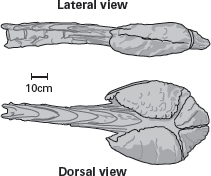
FIGURE 8.12
The tail club of ankylosaurids was made of two large and two small dermal plates. (Drawing by Network Graphics)
Euoplocephalus, from the Upper Cretaceous of Canada and the United States, is a characteristic ankylosaurid that displayed all the features typical of the family (see
figure 8.10). This medium-size to large ankylosaurid (6 to 7 meters long) had a limb skeleton similar to that of
Sauropelta but more massive. Large slabs of bone covered the skull of
Euoplocephalus to armor it completely.
The body armor of
Euoplocephalus consisted of bands of bony plates that ran across the body and tail, as well as smaller bony studs planted throughout the skin. Probably weighing as much as 6 tons,
Euoplocephalus is one of the best-known ankylosaurids. Other well-known ankylosaurids include
Ankylosaurus, from the Upper Cretaceous of the United States and Canada, and
Pinacosaurus and
Saichania, from the Upper Cretaceous of China and Mongolia. Our knowledge of ankylosaur diversity is growing rapidly, with new discoveries every year (
box 8.5).
Modern military tank design is based on balancing three factors: speed, armor, and firepower. An increase in tank speed results from a decrease in armor and firepower (weight) and vice versa. The ankylosaur design of a dinosaurian “tank” clearly sacrificed speed for the sake of heavy armor. Increased firepower, in the form of powerful jaws and large teeth, was also obviously avoided by ankylosaurs.
The robust and heavy limbs of ankylosaurs were not designed for speed, but for slow and powerful walking. The chassis upon which ankylosaur armor was hung consisted of a wide rib cage with broad ribs and a remarkably broad sacrum (see
figure 8.10). Huge ilia hung down from the sacrum, draped over the upper thighs to provide additional protection. A heavy armor coating of round or rectangular plates was laid over this chassis. Plates arranged in rows, and not sutured to each other, helped the ankylosaur maintain some flexibility within this body covering.
Nodosaurids stopped with this design, so they probably maintained a modicum of speed. But, ankylosaurids went a step further in sacrificing speed for increased armor. Thus, the head of ankylosaurids acquired bony plating, and a tail club evolved to add some firepower to the slower ankylosaurid “tank.”
In July 2011, a joint field expedition of the New Mexico Museum of Natural History and Science (NMMNHS) and the State Museum of Pennsylvania (SMP) scoured the Upper Cretaceous badlands of northwestern New Mexico looking for dinosaur fossils. On a sandstone flat, SMP curator Robert M. Sullivan discovered an ankylosaur skull and part of its neck armor eroding from the 73-million-year-old rocks. The team excavated the fossil, encasing it in a plaster jacket, and transported it back to the NMMNHS in Albuquerque. There preparation began—cleaning, stabilization, and repair of the skull and armor plates. Uncovering the skull revealed a
Euoplocephalus-like ankylosaurid, but one that differs in the configuration and shape of both the armor plates and the horns on the skull (
box figure 8.5).
BOX FIGURE 8.5
The skull of Ziapelta has uniquely configured and shaped armor plates and horns.
Adding ankylosaur experts from the University of Alberta to the research team, it was decided to name a new kind of ankylosaurid. The researchers coined the name Ziapelta for the new dinosaur. Zia is a Native American sun symbol that is the logo on the New Mexico state flag, and pelta is Latin for “shield,” a common suffix on ankylosaur generic names. A scientific article was written describing the new ankylosaurid and interpreting its significance for ankylosaur evolution. The manuscript was submitted to a scientific journal and after peer review, some revision, and editing, it was published in September 2014. Thus, bringing Ziapelta to the world, from discovery to publication, took a little more than three years!
There seems little doubt that, when attacked, an ankylosaur would not have tried to flee or counterattack. Instead, it would have squatted down, presenting a nearly impervious back to its attacker. Because of the ankylosaur’s low-slung body and great weight, an attacker would have found it difficult to flip the “tank” over to get at its belly. When attacked, ankylosaurids would also have protected their blind backsides by swinging their massive tail clubs back and forth.
The oldest known ankylosaur body fossil is that of Sarcolestes, from the Middle Jurassic of Europe. Although known only from part of a lower jaw, the teeth and an armor plate attached to the jaw identify Sarcolestes as an ankylosaur. Late Jurassic ankylosaurs are known from Europe and North America, notably Gargoyleosaurus, described from a skull found in the Upper Jurassic of Wyoming.
Two types of Mesozoic “tanks” evolved among the ankylosaurs: the somewhat lighter nodosaurids and the very heavy ankylosaurids. But, the hallmark of ankylosaur evolution was conservatism. Once the basic heavily armored, tank-like body plan of these dinosaurs appeared, it was modified very little throughout their evolution.
It is clear that by the Cretaceous, the evolutionary split between nodosaurids and ankylosaurids had taken place. At least 18 genera of Cretaceous nodosaurids are known from Europe, North America, and Australia. Fragmentary ankylosaur fossils from South America and Africa may also be of nodosaurids, but these need to be reassessed. Nodosaurids reached their greatest diversity during the Early to Middle Cretaceous, but they did survive to the Late Cretaceous in the form of Struthiosaurus and Edmontonia in North America.
Ankylosaurids are well known from the Cretaceous of North America, Europe, and Asia. They encompass at least 18 genera, one of which, Ankylosaurus, at 6 to 7 meters long, was the largest ankylosaur. Ankylosaurids reached their greatest diversity during the Late Cretaceous but are not particularly abundant in the fossil record.
1. Thyreophoran dinosaurs include two closely related groups, Stegosauria and Ankylosauria, as well as the primitive thyreophorans, Scutellosaurus and Scelidosaurus.
2. The presence above or alongside the vertebral column of one or more rows of dermal armor plates distinguishes thyreophorans from other dinosaurs.
3. The key evolutionary novelty of stegosaurs is the vertical bony plates and spines arranged in single or double rows along the neck, back, and tail.
4. Huayangosaurus, from the Middle Jurassic of China, is the oldest and most primitive stegosaur known from a complete skeleton.
5. More advanced stegosaurs are the stegosaurids, best represented by Stegosaurus, from the Upper Jurassic of the United States.
6. The plates of Stegosaurus were highly vascularized and probably had a temperature-regulation function.
7. Stegosaurs reached the zenith of their diversity, at least eight genera, and achieved a nearly worldwide distribution during the Late Jurassic. The Cretaceous decline of the stegosaurs and their extinction by Late Cretaceous time may have been due to the appearance of new vegetation (flowering plants) and/or the evolution of new types of plant-eating dinosaurs.
8. One of the key evolutionary novelties of ankylosaurs is their extensive body armor.
9. Two types of ankylosaurs, nodosaurids and ankylosaurids, had evolved by the Early Cretaceous and were distinguished from each other by differences in skull structure and body armor.
10. Ankylosaurs were the “tanks” of the Mesozoic and adopted a defensive strategy based on impervious armor.
11. Although the oldest ankylosaur is of Middle Jurassic age, the conservative evolution of this group of dinosaurs took place primarily during the Cretaceous.
Ankylosauria
Ankylosauridae
armor plates
Emausaurus
endocast
Euoplocephalus
Gargoyleosaurus
Gastonia
Gigantspinosaurus
Huayangosaurus
Nodosauridae
Nodosaurus
Panoplosaurus
Sauropelta
Scelidosaurus
Scutellosaurus
Stegosauria
Stegosauridae
Stegosaurus
Thyreophora
Ziapelta
1. What features identify a dinosaur as a thyreophoran?
2. Why is Scutellosaurus identified as a thyreophoran, and why is it easier to assign Scelidosaurus to the thyreophorans?
3. What are the evolutionary novelties of stegosaurs, and how does Huayangosaurus exemplify them?
4. How are stegosaurids distinguished from Huayangosaurus?
5. What do paleontologists believe were the arrangement and function of the plates of Stegosaurus? Why?
6. How does the evolution of stegosaurs differ from that of ankylosaurs in terms of timing, distribution, and amount of morphological change?
7. How are ankylosaurs distinguished from other dinosaurs? How are nodosaurid ankylosaurs distinguished from ankylosaurids?
8. What defensive strategy did ankylosaurs employ?
Arbour, V. M., et al. 2014. A new ankylosaurid dinosaur from the Upper Cretaceous (Kirtlandian) of New Mexico with implications for ankylosaurid diversity in the Upper Cretaceous of western North America. PLoS ONE 9:e108804. (Names a brand new ankylosaurid, Ziapelta)
Carpenter, K., ed. 2001. The Armored Dinosaurs. Bloomington: Indiana University Press. (A collection of 21 technical articles presenting research on ankylosaurs)
Carpenter, K., 2012. Ankylosaurs, pp. 505–525, in M. K. Brett-Surman, T. R. Holtz, Jr., and J. O. Farlow, eds., The Complete Dinosaur. 2nd ed. Bloomington: Indiana University. (Concise review of the ankylosaurs)
Colbert, E. H. 1981. A Primitive Ornithischian Dinosaur from the Kayenta Formation of Arizona. Flagstaff: Museum of Northern Arizona Press. (Complete description of the primitive thyreophoran Scutellosaurus)
Czerkas, S. A. 1987. A reevaluation of the plate arrangement of Stegosaurus stenops, pp. 83–99, in S. J. Czerkas and E. C. Olson, eds., Dinosaurs Past and Present. Vol. 2. Los Angeles: Natural History Museum of Los Angeles County and University of Washington Press. (Reviews ideas about the plate arrangement of Stegosaurus and argues for a single row of plates)
Farlow, J. O., S. Hayashi, and G. J. Tattersall. 2010. Internal vascularity of the dermal plates of Stegosaurus (Ornithischia, Thyreophora). Swiss Journal of Geosciences 103:173–185. (The latest analysis of thermoregulation by Stegosaurus using its plates)
Farlow, J. O., C. V. Thompson, and D. E. Rosner. 1976. Plates of the dinosaur Stegosaurus: Forced convection heat loss fins? Science 192:1123–1125. (Proposes that the plates of Stegosaurus functioned like the cooling fins of radiators)
Galton, P. M. 2012. Stegosaurs, pp. 483–504, in M. K. Brett-Surman, T. R. Holtz, Jr., and J. O. Farlow, eds., The Complete Dinosaur. 2nd ed. Bloomington: Indiana University Press. (Concise review of the stegosaurs)
Maidment, S. C. R. 2010. Stegosauria: A historical review of the body fossil record and phylogenetic relationships. Swiss Journal of Geosciences 103:199–210. (Reviews stegosaur distribution, taxonomy, and phylogeny)
Maidment, S. C. R., D. B. Norman, P. M. Barrett, and P. Upchurch. 2008. Systematics and phylogeny of Stegosauria (Dinosauria: Ornithischia). Journal of Systematic Palaeontology 6:367–407. (Cladistic analysis of stegosaur phylogeny)
Thompson, R. S., J. C. Parrish, S. C. R. Maidment, and P. M. Barrett. 2012. Phylogeny of the ankylosaurian dinosaurs (Ornithischia: Thyreophora). Journal of Systematic Palaeontology 10:301–312. (Cladistic analysis of ankylosaur phylogeny)
Tiny heads, bulky bodies, weird plates in rows on their backs, and spiky tails identify stegosaurs as some of the most bizarre-looking dinosaurs. Thus, they are popular display fossils in many natural history museums. If you make it to southern China, the Zigong Dinosaur Museum (Sichuan) exhibits a skeleton of the most primitive known stegosaur, Huayangosaurus. Down the road, check out the mounted skeleton of the Late Jurassic stegosaur Tuojiangosaurus in the Chongqing Municipal Museum. But, closer to home, at the Natural History Museum in London, England, you will find a mounted replica of that skeleton of Tuojiangosaurus. Not far away, in Berlin, Germany, you can also see a similar Late Jurassic stegosaur from East Africa, Kentrosaurus, in the Museum für Naturkunde. Famous Yale paleontologist Othniel Charles Marsh coined the name Stegosaurus in 1877, so do make a pilgrimage to the mounted Stegosaurus skeleton at the Yale Peabody Museum of Natural History (New Haven, Connecticut). Stegosaurus is the official state fossil of Colorado, so you can also see one at the Denver Museum of Nature and Science. And, if you go to The Dinosaur Museum (Blanding, Utah), you can see a reconstruction of Stegosaurus with a single row of plates (Marsh’s original idea) by famed dinosaur artist Stephen Czerkas. Between Blanding and New York and beyond, almost every natural history museum has at least a replica (cast) of a skeleton of Stegosaurus.
